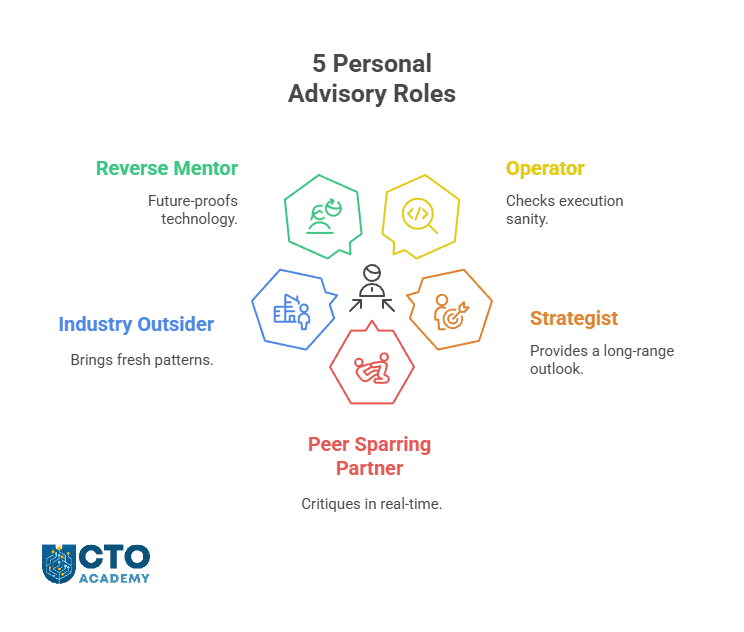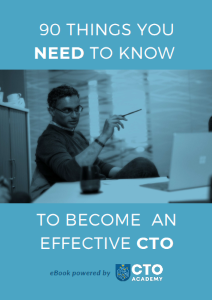Even When You’re the Only Tech Leader in the Room
You’re the lone tech voice at the table, juggling sprint fires, budget trade-offs, and late-night architecture calls—and no one really gets the weight of each decision. It’s the leadership paradox: the higher you climb, the fewer sounding boards you have. Yet research shows that 70 % of professionals actively want more than one mentor so they can triangulate advice and avoid blind spots.
Accidental CTO? Running a three-dev startup on fumes? This playbook shows how to recruit world-class advisors without adding a single headcount—using micro-equity, time-bank swaps, and community leverage.
Instead of chasing a mythical all-knowing guru, try assembling a personal board of advisors—a small portfolio of people who collectively cover strategy, execution, and future-proof insight. In the sections that follow, you’ll see exactly how to build that board even if you’re strapped for cash or time.
TL;DR — Build-a-Board Cheat-Sheet
Problem: Tech leaders often fly solo; one “super-mentor” can’t cover every blind spot.
Solution: Create a Personal Board of Advisors—five roles that together give 360° guidance:
- Operator (execution sanity-check)
- Strategist (long-range outlook)
- Peer Sparring Partner (real-time critique)
- Industry Outsider (fresh patterns)
- Reverse Mentor (future-proof tech).
How to start:
- Use the free Board Gap Mapper to score yourself on 10 leadership skills and spot which roles to fill first.
- Recruit on a zero-budget with micro-equity, time-bank swaps, community, or fractional contracts.
- Keep momentum: send a quarterly one-pager, label each advisor’s “hat,” close the loop on their advice, and give value back.
Shortcut: The CTO Academy Digital MBA and Membership package bundle built-in mentors, peer labs, and operator checklists—ready on day one if DIY networking feels heavy.
Once, hitching your wagon to a single senior “guru” worked because tech stacks, budgets, and career ladders moved slowly. Today’s CTOs juggles AI strategy, cloud economics, talent branding, and investor comms—territory far too sprawling for any one adviser.
Harvard Business Review calls this the “portfolio” era of mentoring and urges professionals to build a personal board of directors instead of chasing unicorn mentors.
Research backs the shift: a National Academies review of STEM mentoring models concludes that “individual mentee needs are unlikely to be met by a single mentor.” At the same time, networked or multi-mentor systems produce stronger skill coverage and career outcomes.
Put bluntly, triangulating advice from three to five voices beats relying on one perspective, reducing blind spots, diversifying insight, and buffering you against adviser churn.
A personal board of advisors is a hand-picked circle of four to six people who collectively plug your skill gaps and sanity-check big calls. Unlike a corporate board, it’s informal and fluid: you set the agenda, cadence (quarterly check-ins plus ad-hoc calls), and term limits.
HBR frames it as a “personal board of directors” and suggests six to eight members so each brings distinct expertise—strategy, execution, network, or fresh tech insight.
MIT Sloan research ultimately confirms that, in today’s complex arena, “one mentor is no longer sufficient,” making a diversified board the stronger career safety net.

Before you start inviting names, it helps to know which seats you actually need. A well-balanced board works like a resilient micro-service architecture: each role solves one critical job, overlaps just enough for fail-over, and collectively covers every leadership blind spot—from day-to-day release realities to long-horizon strategy.
The five roles below are a proven minimum viable set; populate them creatively, and you’ll enjoy 360-degree feedback without bloating payroll.
NOTE: In each role description, you’ll see a short, ready-to-paste message (First DM). Treat it as a cold-open template—the 2-3 sentences you can drop into LinkedIn, Slack, or email when you reach out to a potential advisor. It briefly states who you are, why you value their expertise, and exactly what you’re asking for (time cadence, equity swap, or peer exchange). Personalise the greeting and context, but keep the clear ask intact because a crisp, respectful opener dramatically increases reply rates and sets expectations from the start.
You need someone who’s lived (or is living) your release train reality, so the advice is grounded, not theoretical.
Now, if cash is tight, hire the experience, not the headcount: a fractional CTO typically runs $150-300 per hour—about 10% of a full-time exec’s burn.
TIP: Alumni from a previous employer will often swap guidance for visibility.
What if you need an on-tap “Operator” but can’t possibly afford a senior hire, even if it’s fractional?
Our Global Community quietly fills that gap. You can drop real-world release blockers into a private community of global CTOs, join live “CTO Shadowing” sessions with senior leaders, and pick up ready-to-use checklists from the leadership knowledge base.
It’s like having an experienced operator for the price of a streaming subscription—ideal when you just need a fast sanity-check on deployment cadence or budget trade-offs, not another full-time salary.
Plug in when you hit an operational wall; unplug when you’ve got the answer—no long contracts, no equity dilution, just practical help on demand.
First DM: “Could we trade one sprint of code review for a standing 30-min check-in on scaling our release pipeline?”
This adviser spots the path two funding rounds ahead. Angels already on your cap table, love this role.
Weekly product updates simply morph into quarterly strategy sessions. If you’re accelerator-curious, note that equity-free programmes like the Founder Institute run mentor networks in 100+ countries, so a Strategist may come bundled at zero cash cost.
First DM: “You already see our investor updates—would you wear the ‘Strategist hat’ for one 30-min deep-dive each quarter?”
Think of this as your co-founder emulator: a safe voice that argues back, pressure-tests roadmaps, and does role-play before a board meeting.
Paid peer communities keep the bar high; e.g., GrowthMentor’s ‘Light’ tier is just $50 / month and includes one free mentor call. However, it can be daunting to find a technology leader ready to step in at short notice. Turn to our Community, on the other hand, and there’s a senior tech leadership mentor ready to help you out.
If you are willing to test free options, consider mastermind swaps in Reddit r/startups or local meet-ups.
First DM: “Fancy a 30-minute hot-seat swap each month? You grill my roadmap, I return the favour—recordings optional.”
Great pattern-matching comes from adjacent domains. In other words, a fintech PM might solve your billing pain faster than any health-tech veteran.
Source them via specialised Slack or Discord servers (e.g., Mobilise, Mind the Product) or alumni networks. Offer reciprocal insight: a 15-minute demo of your, for example, AI infra in return for their pricing teardown.
First DM: “Seen your posts in FintechX Slack—could we trade a short call? I’ll show our subscription analytics if you sanity-check the pricing levers.”
A junior engineer, Gen-AI intern, or recent boot-camp grad can sharpen your tech intuition and future-proof your stack.
Cost: $0 plus goodwill, and you’ll score bonus leadership credibility for seeking bottom-up insight.
First DM: “You ship the slickest prompt-engineering tricks on the team. Can we swap: 20 mins of your workflow for a senior-level architecture review?”
Grab our Board Gap Mapper and score yourself 1 – 5 on each of the ten leadership competences that, by the way, mirror our Digital MBA syllabus:
Shade the cells—darkest reds mark your “coverage holes.” Patterns jump out fast: two red columns? Recruit advisors wearing those hats first.
Simply download a .csv and import it into Excel/Sheets.
TIP: The best approach to check for potential expertise gaps is to use our Skills Assessment tool to benchmark against hundreds of senior technology leaders.
You don’t need a hiring budget—just resourcefulness. Here are four zero-budget hacks that founders and accidental CTOs use to lock in high-calibre advisors:
Now for the elephant in the room:
If you don’t know what it means, you really need a serious “upgrade” of your business acumen because these are the basics. But, okay, if you hear “micro-equity” and think Greek, here’s a simple breakdown of the concept:
| Jargon | Plain-English meaning |
|---|---|
| Equity | Ownership units (shares) of your company. |
| Micro-equity | A tiny slice—about one-quarter to one percent of the pie. On a cap-table of 100 shares, that’s 0.25–1 share. |
| FAST (Founder/Advisor Standard Template) | A free, two-page contract from the Founder Institute that spells out: who the advisor is, the % you’re granting, a vesting schedule, and IP/confidentiality terms—no lawyer marathon required (find the template here: fi.co). |
| SAFE (Simple Agreement for Future Equity) | A one-page “IOU” from Y Combinator. It says: when the company next raises money or issues stock, the advisor (or investor) automatically converts their SAFE into that same % of real shares—no valuation debate today (find the template here: ycombinator.com). |
| Vesting over two years | The advisor doesn’t get the full slice on day 1; they earn 1/24-th each month. If they vanish after 6 months, they walk away with only 0.06–0.25 %. |
| Negligible dilution | A tiny slice—about one-quarter to one percent of the pie. On a cap-table of 100 shares, that’s 0.25–1 share. |
Why it works
Think of it as paying an expert with a ticket to your future success—small enough not to hurt today, big enough that they care tomorrow.
Subject: Quick micro-advisory proposal
Hi {name},
I’m the accidental CTO at {startup}. We’re shipping {what you do}, and your expertise in {their speciality} would plug a critical gap for us.
Would you consider a 0.3 % advisor grant (FAST) in exchange for a 30-minute call each quarter and occasional async feedback? I’ll send a concise one-pager before every session to respect your time.
Keen to explore? Happy to answer any questions.
— {You}
Lock the first quarterly slot the moment they say “yes,” share your Board Gap Mapper sheet if you feel like it, and you’ve onboarded your first board member without spending a cent. How about that?
Once your board is in place, momentum beats size. Here’s what you’ll do:
That first friendly advisor feels priceless, so founders hand over 2 % on the spot.
Fix: Cap grants at 0.25–1 % via a FAST/SAFE side letter, vesting over two years and reviewed annually.
“Let’s catch up soon” turns into six silent months.
Fix: Lock a 30-minute quarterly slot the day you onboard—and send a one-page update the week before.
One superstar ends up wearing three hats, creating an echo chamber.
Fix: Label the “hat” (Operator, Strategist, etc.) atop every agenda and recruit extra voices when a seat is empty.
Too busy to chase five micro-advisors?
Our Next Digital MBA cohort bundles a mentor network of fractional CTOs, exited founders, and peer sprints—no equity paperwork required.
90 Things You Need To Know To Become an Effective CTO
